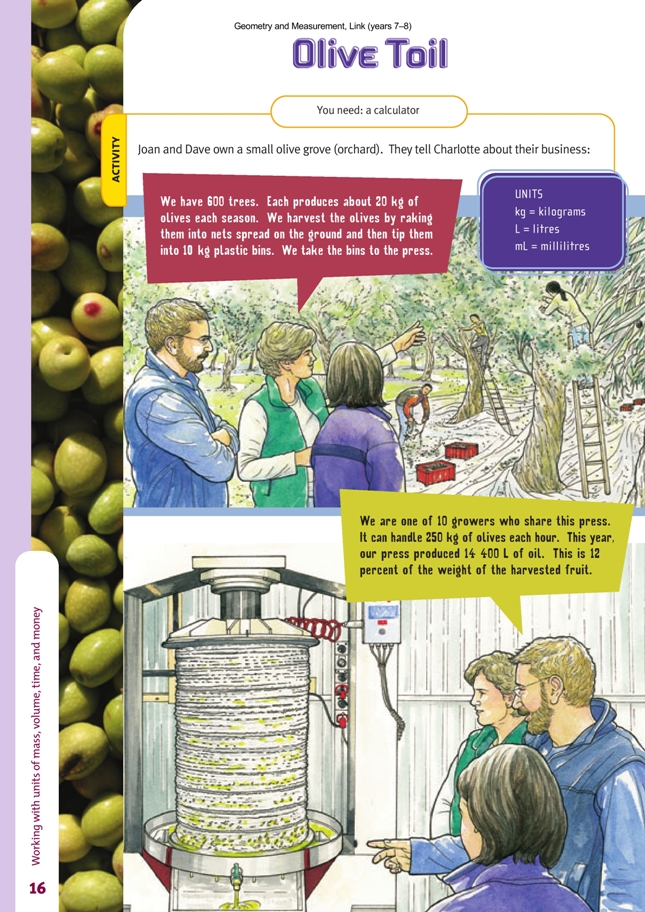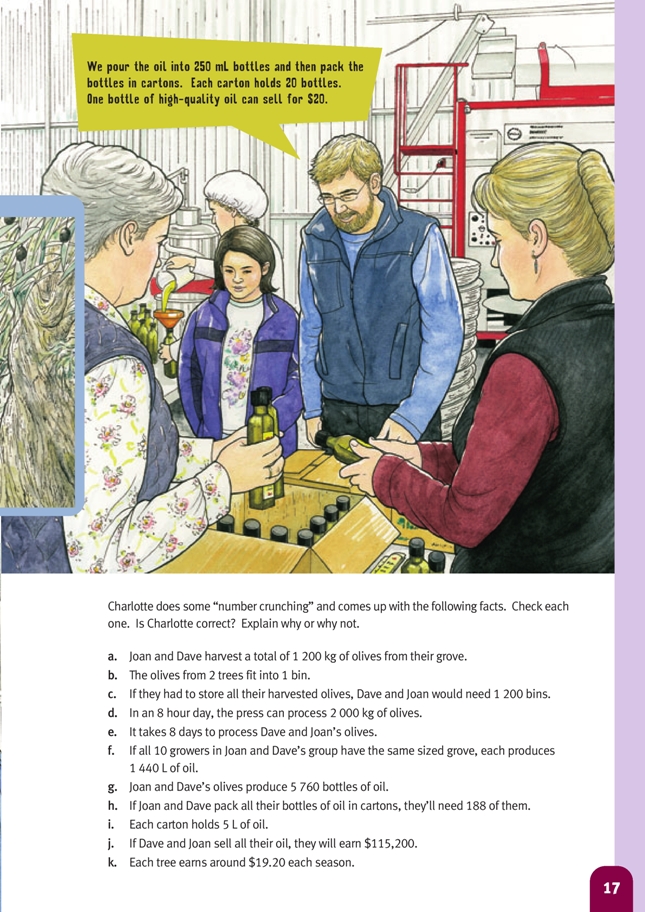This is a level 3 link measurement activity from the Figure It Out series. It relates to Stage 6 and 7 of the Number Framework.
Click on the image to enlarge it. Click again to close. Download PDF (959 KB)
solve problems involving units of mass, volume, money and time
calculator
This activity is based around olive growing and processing. Students are given information and a series of deductions based on that information. They have to read and interpret the information for themselves and use it to check each deduction to see if it is correct. Reasoning must be given. Along the way, students work with rates, a variety of different units, and some fairly large numbers. The activity provides a great context for using estimation skills to check the reasonableness of results. Students at levels 2–3 will need to use a calculator for some of the calculations. Advanced Multiplicative thinkers (Number Framework, stage 7) should take the opportunity to practice their multiplicative strategies.
The important units used in the activity are listed in a panel in the students’ book. Students need a reasonable understanding of these before they start. As long as they have this, their understanding will be strengthened as they work through the statements a–k. It is particularly important that they understand that 1 L = 1 000 mL.
Some students may not have tasted olives or know that they grow on trees and can be pressed to make oil. So you could introduce this activity by showing them some (different varieties of) olives and olive oil and giving the brave ones a chance to have a taste. Ask the students if they know how olives grow, which parts of the world olives traditionally come from, and the common uses for olive oil. They may be surprised to learn that people are prepared to pay big money for this product.
A key to this activity is being able to recognise which information and what calculations are needed to prove or disprove each of Charlotte’s deductions. For example, to prove or disprove the first statement (about the number of kilograms harvested), we need to find out how many trees Joan and Dave have and how much fruit each tree has. The calculation needed is: (number of trees) x (amount of fruit) = 600 x 20 = 12 000 kg. This shows that Charlotte (who thought the harvest was 1 200 kg) has made a place-value mistake.
If your students are having difficulty, put them in small thinking groups of three or four and get them to tackle one statement at a time. Read out a statement and ask them to answer these questions while you summarise their responses on the whiteboard:
1. What question do we need to answer?
2. What information do we need to answer it?
3. What calculations should we do?
4. What is the answer to our calculation?
5. Is the statement true or false?
Let’s look at statement c by way of example:
1. Question: How many bins would Dave and Joan need for all their olives?
2. Information needed: the amount of olives they have (12 000 kg); the amount of olives that will fit in each bin (10 kg)
3. Calculation: amount of olives shared out into 10 kg bins: 12 000 ÷ 10
4. Answer: 12 000 ÷ 10 = 1 200 bins
5. True or false? The statement is true.
After the groups have proved or disproved each statement, bring them back together and ask them to share their thinking. Each member of a group needs to be able to explain the answer as any one of them could be asked to report back. (This is an important rule because it helps everyone to stay involved and puts pressure on students to ask other members of their group for clarification if they don’t understand something.) After a member of one group has been asked to prove or disprove a statement, other groups are given the opportunity to either agree with or refute that group’s answer.
Note that many of the calculations rely on the answers to earlier calculations, so you need to stress to your students that if they are in doubt, they should cross-check with you.
In statement e, assume that the working days are all 8 hours long.
After the activity, promote reflective thinking by asking questions such as these:
- Which number sense strategies did you find useful in this activity?
- What problems did you have? What did you do to overcome them?
- If you were helping someone else who was about to start this activity, what advice or tips would you give them?
Answers to Activity
a. False. 600 trees each with 20 kg of olives = 600 x 20 = 12 000 kg.
b. False. 2 trees would give 20 x 2 = 40 kg of olives.
1 bin holds only 10 kg, so they would need 4 bins for the olives from 2 trees.
c. True. 12 000 kg of olives needs to be shared out into 10 kg bins. 12 000 ÷ 10 = 1 200 bins.
d. True. 8 hours at 250 kg per hour = 8 x 250 = 2 000 kg.
e. False. 12 000 kg at 2 000 kg a day = 12 000 ÷ 2 000 = 6 days.
f. True. 14 400 L of oil produced in total and shared between 10 growers = 14 400 ÷ 10 = 1 440 L each.
g. True. 12% of 600 x 20 = 0.12 x 1 200 = 1 440 L.
Either calculate 1 440 L ÷ 0.25 L = 5 760 bottles, or reason that as 1 L will fill 4 x 250 mL bottles, 1 440 L will fill 1 440 x 4 = 5 760 bottles.
h. False. 5 760 bottles are shared into cartons that fit 20 bottles each. 5 760 bottles ÷ 20 = 288 cartons needed.
i. True. 20 bottles each of 250 mL = 20 x 250 = 5 000 mL or 5 L.
j. True, but only if Joan and Dave can sell all their oil at $20 a bottle. 5 760 x 20 = $115,200
k. False. If Joan and Dave can sell all their oil at $20 per bottle, their total earnings will be $115,200. Earnings divided by number of trees is 115 200 ÷ 600 = $192 per tree.

